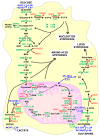Metabolic Reprogramming and the Recovery of Physiological Functionality in 3D Cultures in Micro-Bioreactors
- PMID: 29518979
- PMCID: PMC5874888
- DOI: 10.3390/bioengineering5010022
Metabolic Reprogramming and the Recovery of Physiological Functionality in 3D Cultures in Micro-Bioreactors
Abstract
The recovery of physiological functionality, which is commonly seen in tissue mimetic three-dimensional (3D) cellular aggregates (organoids, spheroids, acini, etc.), has been observed in cells of many origins (primary tissues, embryonic stem cells (ESCs), induced pluripotent stem cells (iPSCs), and immortal cell lines). This plurality and plasticity suggest that probably several basic principles promote this recovery process. The aim of this study was to identify these basic principles and describe how they are regulated so that they can be taken in consideration when micro-bioreactors are designed. Here, we provide evidence that one of these basic principles is hypoxia, which is a natural consequence of multicellular structures grown in microgravity cultures. Hypoxia drives a partial metabolic reprogramming to aerobic glycolysis and an increased anabolic synthesis. A second principle is the activation of cytoplasmic glutaminolysis for lipogenesis. Glutaminolysis is activated in the presence of hypo- or normo-glycaemic conditions and in turn is geared to the hexosamine pathway. The reducing power needed is produced in the pentose phosphate pathway, a prime function of glucose metabolism. Cytoskeletal reconstruction, histone modification, and the recovery of the physiological phenotype can all be traced to adaptive changes in the underlying cellular metabolism. These changes are coordinated by mTOR/Akt, p53 and non-canonical Wnt signaling pathways, while myc and NF-kB appear to be relatively inactive. Partial metabolic reprogramming to aerobic glycolysis, originally described by Warburg, is independent of the cell's rate of proliferation, but is interwoven with the cells abilities to execute advanced functionality needed for replicating the tissues physiological performance.
Keywords: 3D cell culture; Warburg; aerobic glycolysis; bioreactors; glutaminolysis; hypoxia; metabolic reprogramming; organoids; physiological performance; spheroids.
Conflict of interest statement
K.W. and S.J.F. are owners of CelVivo IVS, a company producing equipment and micro-bioreactors for 3D cell culture.
Figures








Similar articles
-
Genomics Analysis of Metabolic Pathways of Human Stem Cell-Derived Microglia-Like Cells and the Integrated Cortical Spheroids.Stem Cells Int. 2019 Nov 18;2019:2382534. doi: 10.1155/2019/2382534. eCollection 2019. Stem Cells Int. 2019. PMID: 31827525 Free PMC article.
-
Metabolic remodeling during somatic cell reprogramming to induced pluripotent stem cells: involvement of hypoxia-inducible factor 1.Inflamm Regen. 2020 May 12;40:8. doi: 10.1186/s41232-020-00117-8. eCollection 2020. Inflamm Regen. 2020. PMID: 32426078 Free PMC article. Review.
-
The Key Role of the WNT/β-Catenin Pathway in Metabolic Reprogramming in Cancers under Normoxic Conditions.Cancers (Basel). 2021 Nov 5;13(21):5557. doi: 10.3390/cancers13215557. Cancers (Basel). 2021. PMID: 34771718 Free PMC article. Review.
-
c-MYC Triggers Lipid Remodelling During Early Somatic Cell Reprogramming to Pluripotency.Stem Cell Rev Rep. 2021 Dec;17(6):2245-2261. doi: 10.1007/s12015-021-10239-2. Epub 2021 Sep 2. Stem Cell Rev Rep. 2021. PMID: 34476741 Free PMC article.
-
The Warburg effect: essential part of metabolic reprogramming and central contributor to cancer progression.Int J Radiat Biol. 2019 Jul;95(7):912-919. doi: 10.1080/09553002.2019.1589653. Epub 2019 Mar 22. Int J Radiat Biol. 2019. PMID: 30822194 Review.
Cited by
-
Characterisation of 3D Bioprinted Human Breast Cancer Model for In Vitro Drug and Metabolic Targeting.Int J Mol Sci. 2022 Jul 4;23(13):7444. doi: 10.3390/ijms23137444. Int J Mol Sci. 2022. PMID: 35806452 Free PMC article.
-
Neutrophil extracellular traps in tumor metabolism and microenvironment.Biomark Res. 2025 Jan 23;13(1):12. doi: 10.1186/s40364-025-00731-z. Biomark Res. 2025. PMID: 39849606 Free PMC article. Review.
-
Genomics Analysis of Metabolic Pathways of Human Stem Cell-Derived Microglia-Like Cells and the Integrated Cortical Spheroids.Stem Cells Int. 2019 Nov 18;2019:2382534. doi: 10.1155/2019/2382534. eCollection 2019. Stem Cells Int. 2019. PMID: 31827525 Free PMC article.
-
Engineering extracellular vesicles by three-dimensional dynamic culture of human mesenchymal stem cells.J Extracell Vesicles. 2022 Jun;11(6):e12235. doi: 10.1002/jev2.12235. J Extracell Vesicles. 2022. PMID: 35716062 Free PMC article.
-
Global Level Quantification of Histone Post-Translational Modifications in a 3D Cell Culture Model of Hepatic Tissue.J Vis Exp. 2022 May 5;(183):10.3791/63606. doi: 10.3791/63606. J Vis Exp. 2022. PMID: 35604167 Free PMC article.
References
LinkOut - more resources
Full Text Sources
Other Literature Sources
Molecular Biology Databases
Research Materials
Miscellaneous

